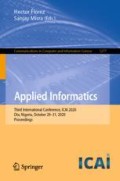Abstract
In the automated screening of cervical cancer using raw micro scoping images, the segmentation of individual cells is time taking and error prone. Therefore, extracting individual cells automatically during inference time is not possible. The automated classification models based on the extraction of hand-crafted features such as texture, morphology, etc. are not very accurate always. In this article, a transfer learning based deep EfficientNet model is used for screening of cervical cancer without any segmentation for reducing manual errors and improving time constraints. Initially, the EfficientNet is trained on the dataset containing original images from the ImageNet dataset and then on the dataset containing the cervical cell microscopic images that consists of different categories of cervix cells. This method has been evaluated on the Herlev Pap smear dataset. Instead of working on individual cells like previous methods, we used to work on images having multiple cells. The number of cells inferred per unit time drastically increases. Results show that EfficientNet model performs well in classification, when applied to the Herlev benchmark Pap smear dataset and evaluated using ten-fold cross-validation. The used model is promising in terms of the time required for the inference as compared to other methods. The performance comparison with other models shows that the accuracy and other scores obtained by EfficientNet is improved with reduction processing time.
Access this chapter
Tax calculation will be finalised at checkout
Purchases are for personal use only
References
Sisodia, D.S., Verma, S.: Image pixel intensity and artificial neural network based method for pattern recognition. World Acad. Sci. Eng. Technol. 57, 742–745 (2011)
Rai, R., Sisodia, D.S.: Real-time data augmentation based transfer learning model for breast cancer diagnosis using histopathological images. In: Advances in Biomedical Engineering and Technology, pp. 473–488. Springer, Singapore
WHO | Cervical cancer.https://www.who.int/cancer/prevention/diagnosis-screening/cervical-cancer/en/
Mitra, P., Mitra, S., Pal, S.K.: Staging of cervical cancer with soft computing. IEEE Trans. Biomed. Eng. 47(7), 934–940 (2000)
Zhang, L., et al.: Automation-assisted cervical cancer screening in manual liquid-based cytology with hematoxylin and eosin staining. Cytometry Part A 85(3), 214–230 (2014)
Zhang, J., Liu, Y.: Cervical cancer detection using SVM based feature screening. In: Barillot, C., Haynor, D.R., Hellier, P. (eds.) MICCAI 2004. LNCS, vol. 3217, pp. 873–880. Springer, Heidelberg (2004). https://doi.org/10.1007/978-3-540-30136-3_106
Kale, A., Aksoy, S.: Segmentation of cervical cell images. In: Proceedings of the 2010 20th International Conference on Pattern Recognition, IEEE Computer Society, pp. 2399–2402 (2010)
Bora, K., Chowdhury, M., Mahanta, L.B., Kundu, M.K., Das, A.K.: Pap smear image classification using convolutional neural network. In: Proceedings of the 10th Indian Conference on Computer Vision, Graphics and Image Processing, p. 55. ACM (2016)
Malli, P.K., Nandyal, S.: Machine learning technique for detection of cervical cancer using k-NN and artificial neural network. In: International Journal of Emerging Trends & Technology in Computer Science (IJETTCS) (2017)
Zhang, L., Lu, L., Nogues, I., Summers, R.M., Liu, S., Yao, J.: DeepPap: deep convolutional networks for cervical cell classification. IEEE J. Biomed. Health Inf. 21(6), 1633–1643 (2017)
Pan, S.J., Yang, Q.: A survey on transfer learning. IEEE Trans. Knowl. Data Eng. 22(10), 1345–1359 (2009)
Tan, M., Le, Q.V.: EfficientNet: rethinking model scaling for convolutional neural networks. arXiv preprint arXiv:1905.11946 (2019)
Byriel, J.: Neuro-fuzzy classification of cells in cervical smears, Master’s Thesis, Technical University of Denmark: Oersted-DTU, Automation (1999)
Martin, E.: Pap-Smear Classification. Technical University of Denmark DTU. 2003 (2003)
LeCun, Y., Bengio, Y., et al.: Convolutional networks for images, speech, and time series. Handb. Brain Theor. Neural Netw. 3361(10), 1995 (1995)
Bloice, M.D., Roth, P.M., Holzinger, A.: Biomedical image augmentation using augmentor. Bioinformatics 35(21), 4522–4524 (2019)
Abadi, M., et al.: Tensorflow: a system for large-scale machine learning. In: 12th USENIX Symposium on Operating Systems Design and Implementation (OSDI 2016), pp. 265–283 (2016)
Deep Learning VM | Google Cloud. https://cloud.google.com/deep-learning-vm
Szegedy, C., Ioffe, S., Vanhoucke, V., Alemi, A.A.: Inception-v4, inception-resnet and the impact of residual connections on learning. In: 31st AAAI Conference on Artificial Intelligence (2017)
Sandler, M., Howard, A., Zhu, M., Zhmoginov, A., Chen, L.-C.: Mobilenetv2: inverted residuals and linear bottlenecks. In: Proceedings of the IEEE Conference on Computer Vision and Pattern Recognition, pp. 4510–4520 (2018)
Tieleman, T., Hinton, G.: Lecture 6.5-rmsprop divide the gradient by a running average of its recent magnitude. COURSERA Neural Netw. Mach. Learn. 4(2), 26–31 (2012)
Russakovsky, O., et al.: Imagenet large scale visual recognition challenge. Int. J. Comput. Vision 115(3), 211–252 (2015)
Srivastava, N., Hinton, G., Krizhevsky, A., Sutskever, I., Salakhutdinov, R.: Dropout: a simple way to prevent neural networks from overfitting. J. Mach. Learn. Res. 15(1), 1929–1958 (2014)
Agarap, A.F.: Deep learning using rectified linear units (relu), arXiv preprint arXiv:1803.08375 (2018)
Author information
Authors and Affiliations
Corresponding author
Editor information
Editors and Affiliations
Rights and permissions
Copyright information
© 2020 Springer Nature Switzerland AG
About this paper
Cite this paper
Khobragade, V., Jain, N., Sisodia, D.S. (2020). Deep Transfer Learning Model for Automated Screening of Cervical Cancer Cells Using Multi-cell Images. In: Florez, H., Misra, S. (eds) Applied Informatics. ICAI 2020. Communications in Computer and Information Science, vol 1277. Springer, Cham. https://doi.org/10.1007/978-3-030-61702-8_28
Download citation
DOI: https://doi.org/10.1007/978-3-030-61702-8_28
Published:
Publisher Name: Springer, Cham
Print ISBN: 978-3-030-61701-1
Online ISBN: 978-3-030-61702-8
eBook Packages: Computer ScienceComputer Science (R0)

